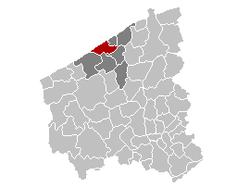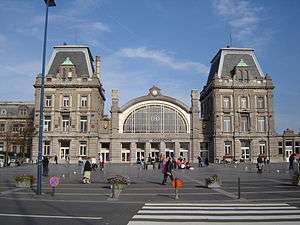Ostend
| Ostend Oostende | |||
|---|---|---|---|
| Municipality | |||
|
Promenade at Ostend seaside | |||
| |||
 Ostend Location in Belgium | |||
|
Location of Ostend in West Flanders  | |||
| Coordinates: 51°14′N 02°55′E / 51.233°N 2.917°ECoordinates: 51°14′N 02°55′E / 51.233°N 2.917°E | |||
| Country | Belgium | ||
| Community | Flemish Community | ||
| Region | Flemish Region | ||
| Province | West Flanders | ||
| Arrondissement | Ostend | ||
| Government | |||
| • Mayor | Johan Vande Lanotte (SP.A) | ||
| • Governing party/ies | SP.A, CD&V, VLD | ||
| Area | |||
| • Total | 37.72 km2 (14.56 sq mi) | ||
| Population (1 January 2016)[1] | |||
| • Total | 70,600 | ||
| • Density | 1,900/km2 (4,800/sq mi) | ||
| Postal codes | 8400 | ||
| Area codes | 059 | ||
| Website | www.oostende.be | ||
Ostend (Dutch: Oostende [oːstˈɛndə]; French: Ostende [ɔstɑ̃d]; German: Ostende [ʔɔstˈʔɛndə])[2] is a Belgian coastal city and municipality, located in the province of West Flanders. It comprises the boroughs of Mariakerke, Raversijde, Stene and Zandvoorde, and the city of Ostend proper – the largest on the Belgian coast.
History
Origin to Middle Ages
In earlier times, Ostend was a small village built on the east-end (oost-einde) of an island (originally called Testerep) between the North Sea and a beach lake. Although small, the village rose to the status of "town" around 1265 when the inhabitants were allowed to hold a market and to build a market hall.
The major source of income for the inhabitants was fishing. The North Sea coastline has always been rather unstable and in 1395 the inhabitants decided to build a new Ostend behind large dikes and further away from the always-threatening sea.
Fifteenth to eighteenth century

.jpg)

The strategic position on the North Sea coast had major advantages for Ostend as a harbour but also proved to be a source of trouble. The town was frequently taken, ravaged, ransacked and destroyed by conquering armies. The Dutch rebels, the Gueuzen, took control of the town. The Siege of Ostend, 1601 to 1604, of which it was said that "the Spanish assailed the unassailable and the Dutch defended the indefensible", cost a combined total of more than 80,000 dead or wounded, making it the single bloodiest battle of the Eighty Years' War. This shocking event set in motion negotiations that led to a truce several years later. When the truce broke down, it became a Dunkirker base.
After this era, Ostend was turned into a harbour of some importance. In 1722, the Dutch again closed off the entrance to the world's biggest harbour of Antwerp, the Westerschelde. Therefore, Ostend rose in importance because the town provided an alternative exit to the sea. The Belgium Austriacum had become part of the Austrian Empire. The Austrian Emperor Charles VI granted the town the trade monopoly with Africa and the Far-East. The Oostendse Compagnie (the "Ostend trade company") was allowed to found colonies overseas. However, in 1727 the Oostendse Compagnie was forced to stop its activities because of Dutch and British pressure. The Netherlands and Britain would not allow competitors on the international trade level. Both nations regarded international trade as "their" privilege.
Modern era
On 19 September 1826 the local artillery magazine exploded. At least 20 people were killed and a further 200 injured. The affluent quarter of d'Hargras was levelled and scarcely a building in the city escaped damage. Disease followed the devastation leading to further deaths.[3]
The harbour of Ostend continued to expand because the harbour dock, as well as the traffic connections with the hinterland, were improved. In 1838, a railway connection with Brussels was constructed. Ostend became a transit harbour to England in 1846 when the first ferry sailed to Dover. Very important for the image of the town was the attention it started to receive from the Belgian kings Leopold I and Leopold II. Both liked to spend their holidays in Ostend. Important monuments and villas were built to please the Royal Family, including the Hippodrome Wellington horse racing track and the Royal Galleries. The rest of aristocratic Belgium followed and soon Ostend became known as "The Queen of the Belgian sea-side resorts".
In 1866 Ostend was the venue for a crucial meeting of exile Spanish Liberals and Republicans which laid the framework for a major uprising in their country, culminating in Spain's Glorious Revolution two years later.
Ostend (in common with nearly the entirety of the country) was occupied by German forces and used as an access point to the sea for submarines and other light naval forces for much of the duration of World War I. As a consequence the port was subjected to two naval assaults by the Royal Navy.
The town hosted all of the sailing events for the 1920 Summer Olympics for Antwerp.[4] Only the finals of the 12 foot dinghy were sailed in Amsterdam. Ostend also hosted the polo events.[5]
World War II involved a second occupation of the town by Germany within a period of little more than twenty years; an occupation which it shared this time with most of northern Europe. Both conflicts brought significant destruction to Ostend. In addition other opulent buildings which had survived the wars were later replaced with structures in the modernist architecture style.
Sights
Ostend is famous for its sea-side esplanade, including the Royal Galleries of Ostend, pier, and fine-sand beaches. Ostend is visited by many day-trippers heading to the beaches, especially during July and August. Tourists from inland Belgium and foreigners mostly arrive by train (day trips) and head for the closest beach area, the Klein Strand, located next to the pier. The locals and other residents in Belgium usually occupy the larger beach (het Groot Strand). Ostend used to be widely visited by the British, Germans, French and Dutch, but is now mainly frequented by Belgians and Dutch.
Near the beach is a well-preserved section of the fortified Atlantic Wall, open to the public as the Atlantic Wall Open Air Museum located in Raversijde. During summer evenings (or just any kind of weather) one can walk through the little streets around Het Vissersplein. At certain times there are local markets in the neighbourhood streets and in the summer the Vissersplein has music festivals. The Vissersplein (Bonenstraat/Kadzandstraat) is a car free zone with many brasseries where patrons can sit outside and have a drink. Towards the port side there are many little fish outlets, and beyond that the ferries can be observed docking.
Interesting locations include:
- the Casino and Fort Napoleon, Ostend.
- Oostende railway station.
- The Mercator, the ex training sailing ship for Belgian merchant navy officers, now open to the public to view.
- Hippodrome Wellington, horse racing venue.
- St Petrus and St Paulus Church, Ostend (Sint-Petrus-en-Pauluskerk), built in Neo Gothic style.
Museums
The James Ensor museum can be visited in the house where the artist lived from 1917 until 1949.
The Mu.Zee (a new museum after the fusion of the Provinciaal Museum voor de Moderne Kunst-Aan-Zee and the "Museum voor Schone Kunsten"), the museum of modern art from the 1830s to the present, displays works of noted local painters such as James Ensor, Leon Spilliaert, Constant Permeke and the revolutionary post-war Belgian COBRA movement amongst others.

Climate
Ostend has a maritime temperate climate, influenced by winds from the North Sea, making summers cooler than inland Europe. 24-hour average temperatures below the freezing point is a rare occurrence. According to the Köppen Climate Classification system, Ostend has a marine west coast climate, abbreviated "Cfb" on climate maps.[6]
| Climate data for Ostend | |||||||||||||
|---|---|---|---|---|---|---|---|---|---|---|---|---|---|
| Month | Jan | Feb | Mar | Apr | May | Jun | Jul | Aug | Sep | Oct | Nov | Dec | Year |
| Average high °C (°F) | 6.1 (43) |
6.5 (43.7) |
9.2 (48.6) |
11.4 (52.5) |
15.3 (59.5) |
17.7 (63.9) |
20.3 (68.5) |
20.9 (69.6) |
18.3 (64.9) |
14.5 (58.1) |
9.7 (49.5) |
7.1 (44.8) |
13.08 (55.55) |
| Average low °C (°F) | 1.1 (34) |
0.5 (32.9) |
2.3 (36.1) |
4.1 (39.4) |
7.9 (46.2) |
10.7 (51.3) |
12.8 (55) |
12.5 (54.5) |
10.2 (50.4) |
7.1 (44.8) |
4.0 (39.2) |
2.3 (36.1) |
6.29 (43.33) |
| Average precipitation mm (inches) | 62.6 (2.465) |
44.5 (1.752) |
55.0 (2.165) |
45.5 (1.791) |
56.2 (2.213) |
66.7 (2.626) |
59.2 (2.331) |
57.3 (2.256) |
79.9 (3.146) |
78.1 (3.075) |
83.9 (3.303) |
73.2 (2.882) |
762.1 (30.005) |
| Average precipitation days | 13 | 9 | 11 | 10 | 10 | 10 | 8 | 8 | 11 | 11 | 13 | 13 | 127 |
| Source: World Meteorological Organisation (UN)[7] | |||||||||||||
Economy
Jetairfly has its headquarters in Ostend.[8] TAAG Angola Airlines's Ostend offices are on the grounds of Ostend Airport in Ostend.[9]
Gallery
 Casino Kursaal
Casino Kursaal Pier
Pier Museumship, the barquentine Mercator
Museumship, the barquentine Mercator Oostende railway station, 2010
Oostende railway station, 2010- Municipal park
.jpg)
 The Peperbusse – local name for an old church tower from a burned down church
The Peperbusse – local name for an old church tower from a burned down church- Fisherman's house from 1729 (Kapucijnenstraat)
Notable residents
References to these notable citizens of Ostend can be found on the oostende.be website.[10]
- Lilian Baels, princess
- Auguste Marie Francois Beernaert, Prime Minister of Belgium and Nobel Peace Prize recipient
- Alfred Belpaire, locomotive engineer
- Gerard Brackx, tourism
- John Crombez, politician
- Cesar De Paepe, syndicalist
- Etienne Elias, painter
- James Ensor, painter
- Marvin Gaye, musician
- Johannes Gysius, historian[11]
- Arno Hintjens, lead-singer of TC Matic
- Karel Jonckheere, writer
- Mimi Lamote, businesswoman
- Stefaan Maene, backstroke swimmer
- August Michiels, sculptor, painter, engraver
- Hubert Minnebo, sculptor
- Marie-José of Belgium, princess, then last queen of Italy
- Divock Origi, footballer born in the city but did not grow up there.
- Louise of Orléans, first queen of the Belgians
- Constant Permeke, expressionist painter
- Roger Remaut, painter
- Raoul Servais, filmmaker
- Gustaaf Sorel, painter
- Leon Spilliaert, painter
- Henri Storck, author, film-maker, and maker of documentaries
- Robert Triffin, economist
- Robert Van De Walle, judoka
- Bart van den Bossche, singer, actor, and radio/TV presenter
- Peter Van Heirseele, aka Herr Seele, cartoonist (Cowboy Henk), painter and performer
- Johan Vande Lanotte, politician
- Rudolf Vanmoerkerke
Sport clubs
- BC Oostende (basketball)
- Hermes Volley Oostende (volleyball)
- K.V. Oostende (football)
- Wellington Golf Oostende (Golf)
In popular culture
Ostend has been used as a film location by numerous directors. The movies Place Vendôme with Catherine Deneuve; Daughters of Darkness[12] with Delphine Seyrig as Countess Bathory; Armaguedon[13] with Alain Delon; Camping Cosmos with Lolo Ferrari; and Ex Drummer based on the novel by Herman Brusselmans were partially shot in Ostend.
The comic Le Bal du rat mort about a dreadful invasion of rats, is set in Ostend.
See also
References
- ↑ Population per municipality as of 1 January 2016 (XLS; 397 KB)
- ↑ Mangold, Max (2005), Das Aussprachewörterbuch, Duden, pp. 598 and 603, ISBN 9783411040667
- ↑ THE EXPLOSION AT OSTEND, The Manchester Guardian and British Volunteer, 30 September 1826
- ↑ "1920 Summer Olympics sailing". Sports-reference.com. Retrieved 22 April 2011.
- ↑ "1920 Summer Olympics polo". Sports-reference.com. Retrieved 22 April 2011.
- ↑ "Climate Summary for Ostend, Belgium". Weatherbase.com. Retrieved 2014-02-13.
- ↑ "World Weather Information Service – Ostend". United Nations. Retrieved 19 January 2011.
- ↑ "TUIfly Academy Brussels." Jetairfly. Retrieved 23 October 2009.
- ↑ "TAAG Offices." TAAG Angola Airlines. Retrieved 23 January 2010.
- ↑ "Oostendse biografieën". Archief.oostende.be. Retrieved 2014-02-13.
- ↑ Kranenborg, J.B. "Ancestors of Cornelis Leendert de Groot". Ninth Generation. Retrieved 25 August 2013.
- ↑ Daughters of Darkness at the Internet Movie Database
- ↑ "Armaguedon". French.imdb.com. 1 May 2009. Retrieved 22 April 2011.
Further reading
External links
| Wikimedia Commons has media related to Ostend. |
 "Ostend". Encyclopædia Britannica. 20 (11th ed.). 1911.
"Ostend". Encyclopædia Britannica. 20 (11th ed.). 1911. Ostend travel guide from Wikivoyage
Ostend travel guide from Wikivoyage- (Dutch) Official website, limited information available in French, English and German.
- Toerisme Oostende – English edition – extensive.
- Ostend Airport – Official website of the international airport of Ostend.
- Official website Port of Oostende
- Oostendse verhalen- Site about the Ostend dialect and culture with Ostend grammatical rules. (mainly in Dutch (nl) and Ostend dialect).
 |
North Sea |  | ||
| North Sea | |
Bredene, De Haan | ||
| ||||
| | ||||
| Middelkerke | Gistel | Oudenburg |




